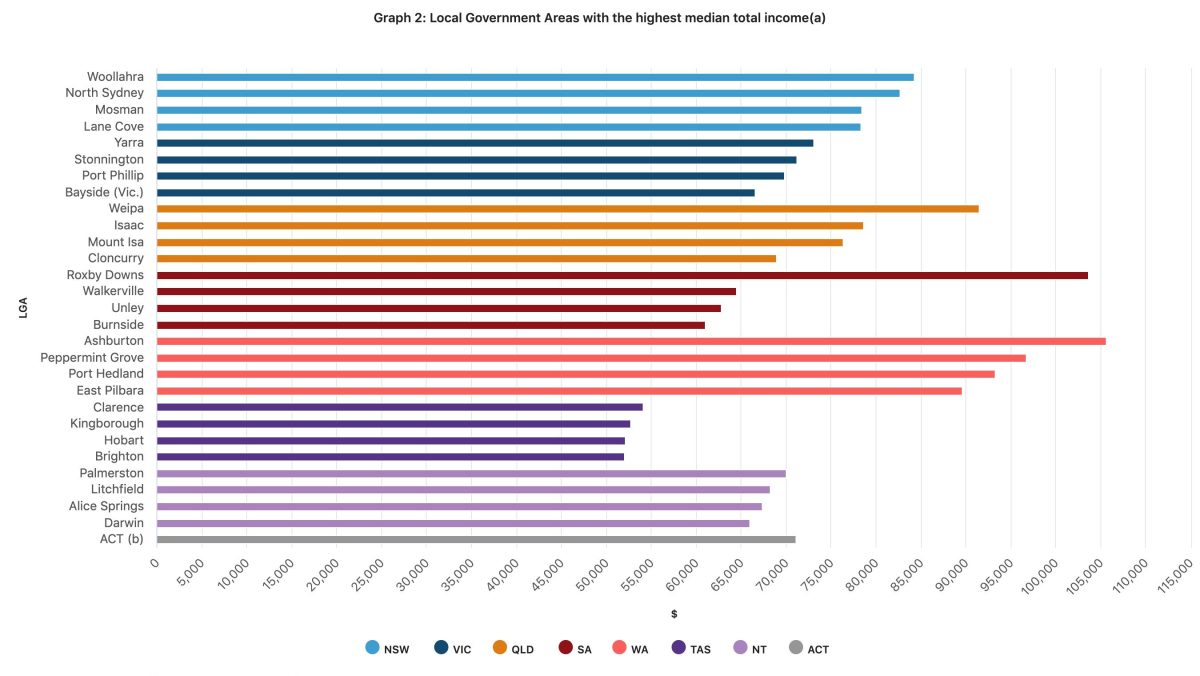SA regions with highest pay packets during pandemic revealed
New jobs and income data showing the impact of the COVID-19 pandemic on labour markets reveals three South Australian regions were among those earning the highest median income in the country.


Unley's gourmet gala. Photo: Supplied
Australian Bureau of Statistics data for 2020-2021 revealed the mining town of Roxby Downs was the local government region that ranked second in the country for highest median total income being earned, at $103,653.
This compared to the top region – another mining area, Ashburton in the Pilbara of Western Australia, with $105,655, and in third place, the top-end-of-town Perth suburb of Peppermint Grove in Western Australia at $96,684.
Other South Australian council areas to make it into the top 29 listed in the country with the highest median total income include Adelaide’s leafy suburbs of Walkerville, Unley and Burnside.
ABS head of labour statistics Bjorn Jarvis said while two recently released reports into personal income tax data were not as timely “as other statistics we produce”, they provide rich data across the nation’s regional communities.
“The two releases – Jobs in Australia and Personal Income in Australia – provide the richest geographical insights into the first year of the COVID-19 pandemic and its impact on labour markets and communities across Australia,” Jarvis said.
This includes insights into regional communities using labour market information for nearly 2,500 regions across Australia and more than 500 local government areas.

When it comes to rising levels of income, the reports showed New South Wales recorded the fastest growth rate in income since 2016-17 at 14 per cent, and South Australia the slowest at 11.4 per cent.
Still in South Australia, the data showed the top one per cent of its earners shared 8 per cent of the total personal income in the state during 2020-2021.
This compared to New South Wales where the top one per cent of earners received the greatest share in the nation of their state’s total personal income at 11.2 per cent.
In 2020-21, the local government areas that had the lowest income inequality in their respective state or territory was Roxby Downs, followed by Palmerston in Northern Territory and Ashburton in Western Australia.
The highest income inequality was in Gwydir in New South Wales, Cleve in South Australia and Cottesloe in Western Australia.
“Overall, there were 20.8 million jobs held in 2020-21, up by more than 800,000 jobs from 2019-20,” Jarvis said.
“Looking at this data on a quarterly basis, we can see that the increase in jobs was mainly in the December 2020 and March 2021 quarters, following the initial falls early in the COVID-19 pandemic in the June and September 2020 quarters.”
A larger-than-usual increase in the number of short-term jobs that people worked during this period boosted the number of jobs held in 2020-2021.
Data showed the number of jobs recorded that lasted between one and thirteen weeks rose by 34 per cent between 2019-20 and 2020-21.
“The increase in short-term jobs – those worked for less than three months – made up 76 per cent of the total increase in jobs in 2020-21,” Jarvis said.
These reports also showed the impact of pandemic-related restrictions on migrants had a significant impact on the nation’s agriculture, forestry and fishing industry.
During 2020-21, 36,900 jobs in the agriculture, forestry and fishing industries were held by working holiday makers, down from more than 70,000 jobs in previous years.
Data also showed the number of temporary visa holders who earned employee income fell from 1.3 million in 2019-20 to 1.1 million in 2020-21.
Compositional changes in the migrant population during this period were also reflected in much higher median employee income for temporary visa holders – rising from $32,000 in 2019-20 to $42,800 in 2020-21.
Jarvis said that the health care and social assistance industry continued to account for the highest share of jobs held by migrants at 14 per cent.
Jobs worked by migrants in this industry also steadily increased over 2020-21 – an increase of 23 per cent to 785,400 jobs in 2020-21 – increasing for both permanent and temporary migrants.




